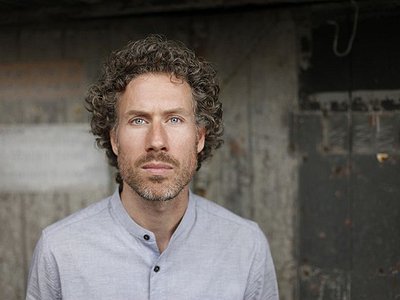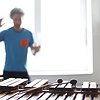Part 1
Fine craftsmanship is the key to understanding Sven Kacirek and his work. The German percussionist, drummer, pianist and composer reworked an old factory floor near Hamburg with his own two hands into his ideal space for living and making music. With love for details and a hunger for precision, he works on his music in the very same way. Every note, and – sometimes even more importantly – every pause is shaped until it fits into its natural place. Besides his cooperations with Nils Frahm, Marc Ribot, Stefan Schneider, Hauschka, F.S. Blumm, Jan Dvorak, Jan Plewka, Martin Bisi, and Alexander Schubert, Sven has composed and performed music for modern dance theatre pieces and contemporary ballet. After his debut album The Palmin Sessions in 2007, Kacirek spent years of finding and recording voices and samples for his “Kenya Sessions” in Africa, which built the very fabric of his 2011 masterpiece album and heard its echoes on his 2012 follow-up Scarlet Pitch Dreams. In late 2014 he returned with a rework of Tchaikovsky´s famous “The Nutcracker”, eight pieces which skip in and out of the limelight of recognition. For many of those in search of the right kind of music for an intelligent Christmas spirit last year, this was it.
When did you start writing music – and what or who were your early passions and influences?
I took my first drum lessons at the age of ten. I always wanted to become a professional drummer playing for different artists. After leaving the music conservatory at Arnhem, Netherlands, in 1999, I totally changed my mind. I realised that I would rather like to create and to record my own music instead of playing drums for other people as a sideman. The same year I met with Uwe Haas. We formed a Trio called “field”. We released two albums and one EP. After these releases I decided to record and produce my first solo album The Palmin Sessions.
What do you personally consider to be the incisive moments in your artistic work and/or career?
First, my parents had some pretty good records: Weather Report, John McLaughlin, Jan Hammer, and of course some Beatles records like Sgt. Pepper and Revolver. These had a major influence on me. Second, I always had great teachers. And third, I remember a few concerts that infected me very strongly when I was about 16 years old: Jack DeJohnette, John McLaughlin, Herbie Hancock.
What are currently your main compositional- and production-challenges?
After re-arranging and re-recording Tchaikovsky´s “Nutcracker”, I am returning to my “Okinawa” project. In 2012 I got a sponsorship by the Goethe-Institute to travel to Okinawa, Japan, where I recorded very old singers from different islands. I am trying to produce these songs by playing other things on top, like I did with The Kenya Sessions. But – comparing it to The Kenya Sessions or The Nutcracker Sessions – I find it much more difficult to devise this production. I started to read some books about Japanese aesthetics and even started to learn Japanese two years ago. But it is still a big challenge to find the “magic key” that leads me deeply into the production of the Okinawa album.
What do you usually start with when working on a new piece?
I am mostly getting my ideas from practising. Then those basic ideas turn into a general idea which includes the instrumentation, the questions what microphones to use, etc.
How strictly do you separate improvising and composing?
I am mostly writing down the parts before I record them. But then I usually realise that it doesn’t work the way I wrote it down. Then it comes to improvisation based on the written part. During the first parts it is a very rational process. But during the improvisation I am more and more getting to the point when it’s better to switch off the head and follow something else.
How do you see the relationship between sound, space and composition?
I do not believe in the differentiation between sound and space. Space or “silence” can create a beautiful sound. “4´33” by John Cage is about sound as well. Composition is always about the question what’s next, no matter if this next required element is a clear audible sound or something that is called silence or space.
Do you feel it important that an audience is able to deduct the processes and ideas behind a work purely on the basis of the music? If so, how do you make them transparent?
My latest album The Nutcracker Sessions is based on the story "The Nutcracker and the Mouse King" by E. T .A. Hoffmann. This was a very important reference point for me.
In my version, the battle of the toy soldiers led by the Nutcracker against the army of the Mouse King unmistakably happens during the album track “Sugar Plum Fairy”. The central theme of transformation recurs like a leitmotif throughout the whole album. I rewrote the final part of my lavish pas-de-deux arrangement and translated it into a punched tape format, so it could be played on a simple music box, before re-recording it. Passages featuring the homemade music box keep recurring throughout. They allude to the existence of an original piece of music and to a by-gone era, in which disc music boxes were the only means of copying and reproducing music.
The Nutcracker Sessions begins and ends with an old cassette recorder. This, too, is a reference to E. T. A. Hoffmannʼs story: Marie, the main character of the narrative, imagines the story and, in the end, is awoken from her spectacular dreams by her mother. I like the idea of someone somewhere sitting in front of an old cassette recorder, putting in a mono cassette tape with a lot of background noise, and pressing play. After the first few bars, the person merely imagines the lavishly produced main part of the album. At the end of “Final Waltz & Apotheosis” the cassette tape ultimately reasserts itself, supplanting the illusion of magnificent soundscapes.
Though there are a lot of dramaturgical ideas behind the record, it is not important at all to know about these details. The most important point is if you enjoy the music, no matter if you have ever heard about Tchaikovsky or E. T. A. Hoffmann. The details are left for the nerdy listeners.






